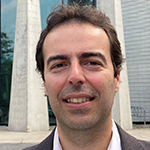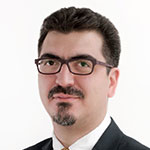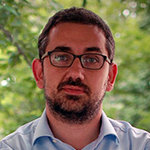SS 01 – Climate Change Effects on Life-Cycle Safety, Reliability, and Risk of Structures and Infrastructure Systems
Fabio Biondini
Politecnico di Milano
Milan, Italy
Zoubir Lounis
National Research Council Canada
Ottawa, ON, Canada
Michel Ghosn
The City College of New York
New York, NY, USA
SS 02 – SHM for Life-Cycle Informed Management of Degrading Structures
Maria Pina Limongelli
Politecnico di Milano
Milan, Italy
Paolo Gardoni
University of Illinois at Urbana-Champaign
Urbana, IL, USA
Sebastian Thöns
Lund University
Lund, Sweden
Dagang Lu
Harbin Institute of Technology
Harbin, China
SS 03 – Monitoring of Structures for Informed Decision Making
Alfred Strauss
University of Natural Resources and Life Sciences
Vienna, Austria
Dan M. Frangopol
Lehigh University
Bethlehem, PA, USA
SS 04 – Artificial Intelligence-Based Life-Cycle Management of Infrastructure Systems
You Dong
The Hong Kong Polytechnic University
Hong Kong, China
Dan M. Frangopol
Lehigh University
Bethlehem, PA, USA
Xiaoming Lei
The Hong Kong Polytechnic University
Hong Kong, China
SS 05 – Concrete Damage Assessment using CODA Waves
Christoph Gehlen
Technical University of Munich
Munich, Germany
Ernst Niederleithinger
Federal Institute for Materials Research and Testing
Berlin, Germany
Jithender Timothy
Technical University of Munich
Munich, Germany
Thomas Kränkel
Technical University of Munich
Munich, Germany
SS 06 – Life-Cycle Redundancy, Robustness, and Resilience Indicators for Aging Structures and Infrastructure Systems under Multiple Hazards
Fabio Biondini
Politecnico di Milano
Milan, Italy
Dan M. Frangopol
Lehigh University
Bethlehem, PA, USA
SS 07 – Bridge Weigh-In-Motion Systems and Applications to Structural Health Monitoring
Samim Mustafa
Indian Institute of Technology
Varanasi, India
Daniel Cantero
Norwegian University
of Science and Technology
Trondheim, Norway
SS 08 – Performance, Safety, and Cost of Civil Infrastructure in a Life-Cycle Context
Yaohan Li
Hong Kong Metropolitan University
Hong Kong, China
Peng Yuan
The Hong Kong Polytechnic University
Hong Kong, China
You Dong
The Hong Kong Polytechnic University
Hong Kong, China
Dan M. Frangopol
Lehigh University
Bethlehem, PA, USA
SS 09 – Risk-Based Prioritization and Monitoring of Bridges for Road Infrastructure Management in Lombardy Region, Italy
Fabio Biondini
Politecnico di Milano
Milan, Italy
Maria Pina Limongelli
Politecnico di Milano
Milan, Italy
Carmelo Gentile
Politecnico di Milano
Milan, Italy
Marco Belloli
Politecnico di Milano
Milan, Italy
SS 10 – Deterioration Modeling of Concrete, Rebar, Steel and Bond Performance
Xiangling Gao
Tongji University
Shanghai, China
Xiaodan Ren
Tongji University
Shanghai, China
Jie Li
Tongji University
Shanghai, China
SS 11 – BRIDGE|50: Experimental Testing and Model Validation for Life-Cycle Design and Assessment of RC/PC Bridges
Fabio Biondini
Politecnico di Milano
Milan, Italy
Francesco Tondolo
Politecnico di Torino
Turin, Italy
Sergio Manto
SCR Piemonte
Turin, Italy
Carlo Beltrami
Lombardi Engineering
Milan, Italy
SS 12 – Exploiting Digitalization in the Intervention Planning for Transportation Infrastructure
Bryan T. Adey
ETH Zurich
Zurich, Switzerland
Saviz Moghtadernejad
ETH Zurich
Zurich, Switzerland
Steven Chuo
ETH Zurich
Zurich, Switzerland
Hamed Mehranfar
ETH Zurich
Zurich, Switzerland
SS 13 – Strengthening and Rehabilitation of Steel Bridges
Xu Jiang
Tongji University
Shanghai, China
Xuhong Qiang
Tongji University
Shanghai, China
Zhilin Lv
Tongji University
Shanghai, China
SS 14 – Data Management and Analysis for Predictive Maintenance of Aging Infrastructure
Franziska Schmidt
Université Gustave Eiffel
Marne-la-Vallée Cedex 2, France
Mezgeen Rasol
Université Gustave Eiffel
Marne-la-Vallée Cedex 2, France
Leandro F.M. Sanchez
uOttawa
Ottawa, Canada
SS 15 – Reinforced Concrete-to-Concrete Interfaces: Experiments and Modelling
Vasiliki Palieraki
National Technical University of Athens
Athens, Greece
Sara Cattaneo
Politecnico di Milano
Milan, Italy
SS 16 – Risk-Informed Life-Cycle Management of Bridges
Ilaria Venanzi
University of Perugia
Perugia, Italy
Maria Pina Limongelli
Politecnico di Milano
Milan, Italy
Umberto Alibrandi
Aarhus University
Aarhus, Denmark
SS 17 – BIM-Based Sustainability Considerations in Infrastructure Construction
Markus König
Ruhr-Universität Bochum
Bochum,Germany
SS 18 – Optimization of Inspection, Monitoring and Maintenance Strategies for Existing Concrete Structures
Robby Caspeele
Ghent University
Ghent, Belgium
Wouter Botte
Ghent University
Ghent, Belgium
Geert Lombaert
KU Leuven
Leuven, Belgium
Alfred Strauss
University of Natural Resources
and Life Sciences
Vienna, Austria
SS 19 – Sustainability of Steel Production Chain
Helena Gervasio
University of Coimbra
Coimbra, Portugal
Marta Maria Sesana
University of Brescia
Brescia, Italy
SS 20 – Advances in Performance and Life-Cycle Design Of Green Structural Materials for a More Sustainable Environment
Beatrice Belletti
University of Parma
Parma, Italy
Patrizia Bernardi
University of Parma
Parma, Italy
Alice Sirico
University of Parma
Parma, Italy
SS 21 – Durability of Reinforced Concrete Structures and Infrastructures under Changing Climate Conditions
Sylvia Kessler
Helmut‐Schmidt-University
University of the Federal Armed Forces
Hamburg, Germany
Francesca Marsili
Helmut‐Schmidt-University
University of the Federal Armed Forces
Hamburg, Germany
Pietro Croce
University of Pisa
Pisa, Italy
Filippo Landi
University of Pisa
Pisa, Italy
SS 22 – Life-Cycle and Sustainability of Precast Concrete Structures
Bruno Dal Lago
University of Insubria
Varese, Italy
Hugo Rodrigues
Universidade do Aveiro
Aveiro, Portugal
Paolo Negro
European Commission,
Joint Research Centre
Ispra, Italy
SS 23 – Shaping Development Planning Processes for Infrastructure Systems under Future Uncertainty
Bryan Adey
ETH Zürich
Zürich, Switzerland
Arnór Elvarsson
ETH Zürich
Zürich, Switzerland
Orlando Román
ETH Zürich
Zürich, Switzerland
SS 24 – Functional End-of-Life Framework Applied to Hydraulic Structures
Evert Jan Hamerslag
Rijkswaterstaat
Utrecht, The Netherlands
Esther van Baaren
Deltares
Delft, The Netherlands
Alexander Bakker
Delft University of Technology
Delft, The Netherlands
SS 25 – The Process of Decarbonization: From Ideation to Specification
David Shook
Skidmore, Owings & Merrill
San Francisco, CA, USA
Mark Sarkisian
Skidmore, Owings & Merrill
San Francisco, CA, USA
SS 26 – Structural Resilience in Bridge Engineering: Method, Theory, and Practice
Airong Chen
Tongji University
Shanghai, China
Xuhui He
Central South University
Changsha, China
Xin Ruan
Tongji University
Shanghai, China
SS 27 – Practical Applications and Value of Advanced Computational and Probabilistic Modelling in Life-Cycle Engineering
Paolo Bocchini
Lehigh University
Bethlehem, PA, USA
Alfred Strauss
University of Natural Resources
and Life Sciences
Vienna, Austria
Helder Sousa
Brisa Group
São Domingos de Rana, Portugal
SS 28 – Use of SHM and NDE for Decision Making
Nurdan M. Apaydin
Istanbul University-Cerrahpasa
Istanbul, Turkey
F. Necati Catbas
University of Central Florida
Orlando, FL, USA
Bruno Briseghella
Fuzhou University
Fuzhou, China
SS 29 – Durability and Structural Assessment of Fiber Reinforced Strengthening Materials and Strengthened Structures
Francesco Micelli
University of Salento
Lecce, Italy
Corina Papanicolaou
University of Patras
Aristotelous, Greece
Bahman Ghiassi
University of Birmingham
Birmingham, UK
Marianovella Leone
University of Salento
Lecce, Italy
SS 30 – Durability of Sustainable Reinforced Concrete for Civil Engineering Structures
Maddalena Carsana
Politecnico di Milano
Milan, Italy
Elena Redaelli
Politecnico di Milano
Milan, Italy
SS 31 – Structural Health Monitoring and Asset Management of Infrastructures
Shaikha AlSanad
Kuwait Institute for Scientific Research
Safat, Kuwait
Jafarali Parol
Kuwait Institute for Scientific Research
Safat, Kuwait
SS 32 – Corrosion-Induced Structural Damage and Prevention Measures for Reinforced Concrete Infrastructure
Shangtong Yang
University of Strathclyde
Glasgow, UK
Fujian Tang
Dalian University of Technology
Dalian, China
Weiping Zhang
Tongji University
Shanghai, China
SS 33 – Life-cycle and Sustainability Performance of Fastenings
Panagiotis Spyridis
Technical University of Dortmund,
Dortmund, Germany
Giovanni Muciaccia
Politecnico di Milano
Milan, Italy
Konrad Bergmeister
University of Natural Resources
and Life Sciences
Vienna, Austria
Thilo Pregartner
fischerwerke GmbH & Co. KG
Waldachtal, Germany
Roberto Piccinin
Hilti Corporation
Schaan, Liechtenstein
Thomas Sippel
Peikko Group Corporation
Lahti, Finland


























































































